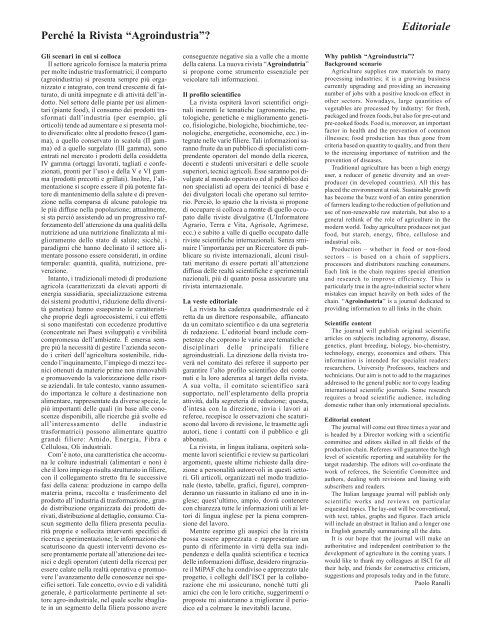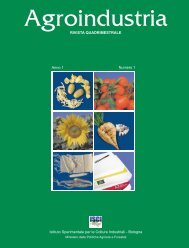Istituto Sperimentale per le Colture Industriali - Bologna ... - isci.it
Istituto Sperimentale per le Colture Industriali - Bologna ... - isci.it
Istituto Sperimentale per le Colture Industriali - Bologna ... - isci.it
You also want an ePaper? Increase the reach of your titles
YUMPU automatically turns print PDFs into web optimized ePapers that Google loves.
Perché la Rivista “Agroindustria”?<br />
Gli scenari in cui si colloca<br />
Il settore agricolo fornisce la materia prima<br />
<strong>per</strong> molte industrie trasformatrici; il comparto<br />
(agroindustria) si presenta sempre più organizzato<br />
e integrato, con trend crescente di fatturato,<br />
di un<strong>it</strong>à impegnate e di attiv<strong>it</strong>à dell’indotto.<br />
Nel settore del<strong>le</strong> piante <strong>per</strong> usi alimentari<br />
(piante food), il consumo dei prodotti trasformati<br />
dall’industria (<strong>per</strong> esempio, gli<br />
orticoli) tende ad aumentare e si presenta molto<br />
diversificato: oltre al prodotto fresco (I gamma),<br />
a quello conservato in scatola (II gamma)<br />
ed a quello surgelato (III gamma), sono<br />
entrati nel mercato i prodotti della cosiddetta<br />
IV gamma (ortaggi lavorati, tagliati e confezionati,<br />
pronti <strong>per</strong> l’uso) e della V e VI gamma<br />
(prodotti precotti e grillati). Inoltre, l’alimentazione<br />
si scopre essere il più potente fattore<br />
di mantenimento della salute e di prevenzione<br />
nella comparsa di alcune patologie tra<br />
<strong>le</strong> più diffuse nella popolazione; attualmente,<br />
si sta <strong>per</strong>ciò assistendo ad un progressivo rafforzamento<br />
dell’attenzione da una qual<strong>it</strong>à della<br />
nutrizione ad una nutrizione finalizzata al miglioramento<br />
dello stato di salute; sicchè, i<br />
paradigmi che hanno declinato il settore alimentare<br />
possono essere considerati, in ordine<br />
tempora<strong>le</strong>: quant<strong>it</strong>à, qual<strong>it</strong>à, nutrizione, prevenzione.<br />
Intanto, i tradizionali metodi di produzione<br />
agricola (caratterizzati da e<strong>le</strong>vati apporti di<br />
energia sussidiaria, specializzazione estrema<br />
dei sistemi produttivi, riduzione della divers<strong>it</strong>à<br />
genetica) hanno esas<strong>per</strong>ato <strong>le</strong> caratteristiche<br />
proprie degli agroecosistemi, i cui effetti<br />
si sono manifestati con eccedenze produttive<br />
(concentrate nei Paesi sviluppati) e vivibil<strong>it</strong>à<br />
compromessa dell’ambiente. È emersa sempre<br />
più la necess<strong>it</strong>à di gestire l’azienda secondo<br />
i cr<strong>it</strong>eri dell’agricoltura sostenibi<strong>le</strong>, riducendo<br />
l’inquinamento, l’impiego di mezzi tecnici<br />
ottenuti da materie prime non rinnovabili<br />
e promuovendo la valorizzazione del<strong>le</strong> risorse<br />
aziendali. In ta<strong>le</strong> contesto, vanno assumendo<br />
importanza <strong>le</strong> colture a destinazione non<br />
alimentare, rappresentate da diverse specie, <strong>le</strong><br />
più importanti del<strong>le</strong> quali (in base al<strong>le</strong> conoscenze<br />
disponibili, al<strong>le</strong> ricerche già svolte ed<br />
all’interessamento del<strong>le</strong> industrie<br />
trasformatrici) possono alimentare quattro<br />
grandi filiere: Amido, Energia, Fibra e<br />
Cellulosa, Oli industriali.<br />
Com’è noto, una caratteristica che accomuna<br />
<strong>le</strong> colture industriali (alimentari e non) è<br />
che il loro impiego risulta strutturato in filiere,<br />
con il col<strong>le</strong>gamento stretto fra <strong>le</strong> successive<br />
fasi della catena: produzione in campo della<br />
materia prima, raccolta e trasferimento del<br />
prodotto all’industria di trasformazione, grande<br />
distribuzione organizzata dei prodotti derivati,<br />
distribuzione al dettaglio, consumo. Ciascun<br />
segmento della filiera presenta peculiar<strong>it</strong>à<br />
proprie e sol<strong>le</strong>c<strong>it</strong>a interventi specifici di<br />
ricerca e s<strong>per</strong>imentazione; <strong>le</strong> informazioni che<br />
scaturiscono da questi interventi devono essere<br />
prontamente portate all’attenzione dei tecnici<br />
e degli o<strong>per</strong>atori (utenti della ricerca) <strong>per</strong><br />
essere calate nella realtà o<strong>per</strong>ativa e promuovere<br />
l’avanzamento del<strong>le</strong> conoscenze nei specifici<br />
settori. Ta<strong>le</strong> concetto, ovvio e di valid<strong>it</strong>à<br />
genera<strong>le</strong>, è particolarmente <strong>per</strong>tinente al settore<br />
agro-industria<strong>le</strong>, nel qua<strong>le</strong> scelte sbagliate<br />
in un segmento della filiera possono avere<br />
conseguenze negative sia a val<strong>le</strong> che a monte<br />
della catena. La nuova rivista “Agroindutria”<br />
si propone come strumento essenzia<strong>le</strong> <strong>per</strong><br />
veicolare tali informazioni.<br />
Il profilo scientifico<br />
La rivista osp<strong>it</strong>erà lavori scientifici originali<br />
inerenti <strong>le</strong> tematiche (agronomiche, patologiche,<br />
genetiche e miglioramento genetico,<br />
fisiologiche, biologiche, biochimiche, tecnologiche,<br />
energetiche, economiche, ecc.) integrate<br />
nel<strong>le</strong> varie filiere. Tali informazioni saranno<br />
fru<strong>it</strong>e da un pubblico di specialisti comprendente<br />
o<strong>per</strong>atori del mondo della ricerca,<br />
docenti e studenti univers<strong>it</strong>ari e del<strong>le</strong> scuo<strong>le</strong><br />
su<strong>per</strong>iori, tecnici agricoli. Esse saranno poi divulgate<br />
al mondo o<strong>per</strong>ativo ed al pubblico dei<br />
non specialisti ad o<strong>per</strong>a dei tecnici di base e<br />
dei divulgatori locali che o<strong>per</strong>ano sul terr<strong>it</strong>orio.<br />
Perciò, lo spazio che la rivista si propone<br />
di occupare si colloca a monte di quello occupato<br />
dal<strong>le</strong> riviste divulgative (L’Informatore<br />
Agrario, Terra e V<strong>it</strong>a, Agriso<strong>le</strong>, Agrimese,<br />
ecc.) e sub<strong>it</strong>o a val<strong>le</strong> di quello occupato dal<strong>le</strong><br />
riviste scientifiche internazionali. Senza sminuire<br />
l’importanza <strong>per</strong> un Ricercatore di pubblicare<br />
su riviste internazionali, alcuni risultati<br />
mer<strong>it</strong>ano di essere portati all’attenzione<br />
diffusa del<strong>le</strong> realtà scientifiche e s<strong>per</strong>imentali<br />
nazionali, più di quanto possa assicurare una<br />
rivista internaziona<strong>le</strong>.<br />
La veste ed<strong>it</strong>oria<strong>le</strong><br />
La rivista ha cadenza quadrimestra<strong>le</strong> ed è<br />
retta da un direttore responsabi<strong>le</strong>, affiancato<br />
da un com<strong>it</strong>ato scientifico e da una segreteria<br />
di redazione. L’ed<strong>it</strong>orial board include competenze<br />
che coprono <strong>le</strong> varie aree tematiche e<br />
d<strong>isci</strong>plinari del<strong>le</strong> principali filiere<br />
agroindustriali. La direzione della rivista troverà<br />
nel com<strong>it</strong>ato dei referee il supporto <strong>per</strong><br />
garantire l’alto profilo scientifico dei contenuti<br />
e la loro aderenza al target della rivista.<br />
A sua volta, il com<strong>it</strong>ato scientifico sarà<br />
supportato, nell’esp<strong>le</strong>tamento della propria<br />
attiv<strong>it</strong>à, dalla segreteria di redazione; questa,<br />
d’intesa con la direzione, invia i lavori ai<br />
referee, recepisce <strong>le</strong> osservazioni che scaturiscono<br />
dal lavoro di revisione, <strong>le</strong> trasmette agli<br />
autori, tiene i contatti con il pubblico e gli<br />
abbonati.<br />
La rivista, in lingua <strong>it</strong>aliana, osp<strong>it</strong>erà solamente<br />
lavori scientifici e review su particolari<br />
argomenti, queste ultime richieste dalla direzione<br />
a <strong>per</strong>sonal<strong>it</strong>à autorevoli in questi settori.<br />
Gli articoli, organizzati nel modo tradiziona<strong>le</strong><br />
(testo, tabel<strong>le</strong>, grafici, figure), comprenderanno<br />
un riassunto in <strong>it</strong>aliano ed uno in ing<strong>le</strong>se;<br />
quest’ultimo, ampio, dovrà contenere<br />
con chiarezza tutte <strong>le</strong> informazioni utili ai <strong>le</strong>ttori<br />
di lingua ing<strong>le</strong>se <strong>per</strong> la piena comprensione<br />
del lavoro.<br />
Mentre esprimo gli auspici che la rivista<br />
possa essere apprezzata e rappresentare un<br />
punto di riferimento in virtù della sua indipendenza<br />
e della qual<strong>it</strong>à scientifica e tecnica<br />
del<strong>le</strong> informazioni diffuse, desidero ringraziare<br />
il MiPAF che ha condiviso e apprezzato ta<strong>le</strong><br />
progetto, i col<strong>le</strong>ghi dell’ISCI <strong>per</strong> la collaborazione<br />
che mi assicurano, nonché tutti gli<br />
amici che con <strong>le</strong> loro cr<strong>it</strong>iche, suggerimenti o<br />
proposte mi aiuteranno a migliorare il <strong>per</strong>iodico<br />
ed a colmare <strong>le</strong> inev<strong>it</strong>abili lacune.<br />
Ed<strong>it</strong>oria<strong>le</strong><br />
Why publish “Agroindustria”?<br />
Background scenario<br />
Agriculture supplies raw materials to many<br />
processing industries; <strong>it</strong> is a growing business<br />
currently upgrading and providing an increasing<br />
number of jobs w<strong>it</strong>h a pos<strong>it</strong>ive knock-on effect in<br />
other sectors. Nowadays, large quant<strong>it</strong>ies of<br />
vegetab<strong>le</strong>s are processed by industry: for fresh,<br />
packaged and frozen foods, but also for pre-cut and<br />
pre-cooked foods. Food is, moreover, an important<br />
factor in health and the prevention of common<br />
illnesses; food production has thus gone from<br />
cr<strong>it</strong>eria based on quant<strong>it</strong>y to qual<strong>it</strong>y, and from there<br />
to the increasing importance of nutr<strong>it</strong>ion and the<br />
prevention of diseases.<br />
Trad<strong>it</strong>ional agriculture has been a high energy<br />
user, a reducer of genetic divers<strong>it</strong>y and an overproducer<br />
(in developed countries). All this has<br />
placed the environment at risk. Sustainab<strong>le</strong> growth<br />
has become the buzz word of an entire generation<br />
of farmers <strong>le</strong>ading to the reduction of pollution and<br />
use of non-renewab<strong>le</strong> raw materials, but also to a<br />
general rethink of the ro<strong>le</strong> of agriculture in the<br />
modern world. Today agriculture produces not just<br />
food, but starch, energy, fibre, cellulose and<br />
industrial oils.<br />
Production – whether in food or non-food<br />
sectors – is based on a chain of suppliers,<br />
processors and distributors reaching consumers.<br />
Each link in the chain requires special attention<br />
and research to improve efficiency. This is<br />
particularly true in the agro-industrial sector where<br />
mistakes can impact heavily on both sides of the<br />
chain. “Agroindustria” is a journal dedicated to<br />
providing information to all links in the chain.<br />
Scientific content<br />
The journal will publish original scientific<br />
artic<strong>le</strong>s on subjects including agronomy, disease,<br />
genetics, plant breeding, biology, bio-chemistry,<br />
technology, energy, economics and others. This<br />
information is intended for specialist readers:<br />
researchers, Univers<strong>it</strong>y Professors, teachers and<br />
technicians. Our aim is not to add to the magazines<br />
addressed to the general public nor to copy <strong>le</strong>ading<br />
international scientific journals. Some research<br />
requires a broad scientific audience, including<br />
domestic rather than only international specialists.<br />
Ed<strong>it</strong>orial content<br />
The journal will come out three times a year and<br />
is headed by a Director working w<strong>it</strong>h a scientific<br />
comm<strong>it</strong>tee and ed<strong>it</strong>ors skil<strong>le</strong>d in all fields of the<br />
production chain. Referees will guarantee the high<br />
<strong>le</strong>vel of scientific reporting and su<strong>it</strong>abil<strong>it</strong>y for the<br />
target readership. The ed<strong>it</strong>ors will co-ordinate the<br />
work of referees, the Scientific Comm<strong>it</strong>tee and<br />
authors, dealing w<strong>it</strong>h revisions and liasing w<strong>it</strong>h<br />
subscribers and readers.<br />
The Italian language journal will publish only<br />
scientific works and reviews on particular<br />
erquested topics. The lay-out will be conventional,<br />
w<strong>it</strong>h text, tab<strong>le</strong>s, graphs and figures. Each artic<strong>le</strong><br />
will include an abstract in Italian and a longer one<br />
in English generally summarising all the data.<br />
It is our hope that the journal will make an<br />
author<strong>it</strong>ative and independent contribution to the<br />
development of agriculture in the coming years. I<br />
would like to thank my col<strong>le</strong>agues at ISCI for all<br />
their help, and friends for constructive cr<strong>it</strong>icism,<br />
suggestions and proposals today and in the future.<br />
Paolo Ranalli



